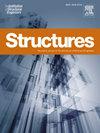基于股链单位数值模型的索鞍系统多维力及其定量关系
IF 4.3
2区 工程技术
Q1 ENGINEERING, CIVIL
引用次数: 0
摘要
受众多钢丝影响的索鞍系统的多维力学行为仍然知之甚少,并且缺乏可量化的关系,使这些系统的防滑设计变得复杂。本研究开发了具有五种链规格的单链数值模型,并通过两次大规模试验进行了验证。澄清了内力和外力,分析了横向力(Fy)和竖向力(Fz)的竞争机制。引入比值K (=Fy/Fz)作为评价关键参数影响的定量指标,并拟合出实用公式。对两座多塔悬索桥进行了实例分析。结果表明,随着钢丝的积累,内部接触力增大,形成明显的菱形力链,同时钢丝之间发生垂直传递。在底部,横向力急剧减小,垂直力在中心较大,在两侧较小。导线通常达到最大摩擦状态。随着股数的增加,垂直力呈线性上升,而横向力呈幂函数增长。钢绞线张力对K值没有影响,但减小摩擦和增大线径会提高K值。在实际的索鞍系统中,垂直力呈箭头状分布,当没有垂直板或完全安装垂直板时,横向力的分布也类似。当鞍座划分为子鞍座时,侧向力呈交错分布;K在子鞍内几乎保持不变,但在子鞍间变化突然。增加竖板显著提高了横向力的摩擦分量,有效解决了多塔悬索桥的防滑难题。现有的侧向力公式在这方面是不够的,而提出的数值模型和实用公式为这一目的提供了有价值的工具。本文章由计算机程序翻译,如有差异,请以英文原文为准。
Multidimensional forces and their quantitative relationships in cable-saddle system based on strand-unitized numerical model
The multidimensional mechanical behavior of cable-saddle systems, influenced by numerous steel wires, remains poorly understood, and the absence of quantifiable relationships complicates anti-slip design in these systems. This study develops a strand-unitized numerical model with five strand specifications, validated through two large-scale tests. It clarifies the internal and external forces and analyzes the competitive mechanism between lateral force (Fy) and vertical force (Fz). A ratio K (=Fy/Fz) is introduced as a quantitative indicator to assess the influence of key parameters, with a practical formula fitted. Case studies on two multi-tower suspension bridges are conducted. Results indicate that as the wires accumulate, the internal contact force increases, forming a distinct diamond-shaped force chain, while vertical transmission occurs between strands. At the bottom, the lateral force sharply decreases, with the vertical force larger in the center and smaller at the sides. The wires generally reach a state of maximum friction. As the number of strands increases, vertical force rises linearly, while lateral force exhibits power function growth. Strand tension does not affect K, but reducing friction and increasing wire diameter enhance it. In actual cable-saddle systems, vertical force shows an arrow-shaped distribution, with a similar distribution for lateral force occurring when vertical plates are absent or fully installed. When the saddle is divided into sub-saddles, the lateral force shows an interleaved distribution; K remains nearly constant within sub-saddles but changes abruptly between them. Increasing the vertical plates significantly enhances the frictional component of lateral force, effectively addressing the anti-slip challenges of multi-tower suspension bridges. The existing lateral force formula is insufficient in this regard, whereas the proposed numerical model and practical formulas offer valuable tools for this purpose.
求助全文
通过发布文献求助,成功后即可免费获取论文全文。
去求助
来源期刊

Structures
Engineering-Architecture
CiteScore
5.70
自引率
17.10%
发文量
1187
期刊介绍:
Structures aims to publish internationally-leading research across the full breadth of structural engineering. Papers for Structures are particularly welcome in which high-quality research will benefit from wide readership of academics and practitioners such that not only high citation rates but also tangible industrial-related pathways to impact are achieved.
 求助内容:
求助内容: 应助结果提醒方式:
应助结果提醒方式:


